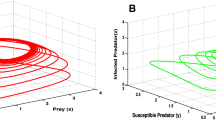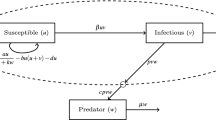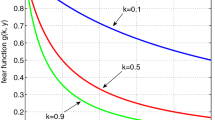Abstract
In this article, an eco-epidemic predator–prey model has been considered where the reproduction of susceptible class of prey is assumed to be affected by the induced fear from predators. The positivity and boundedness of solutions along with existence criterion of the non-negative equilibrium points and their local stability analysis have been performed. Hopf-bifurcation analysis with direction around the co-existence equilibrium point is also performed and it is found that the interference competition rate leads the system to Hopf bifurcation and increases the stable co-existence of all the populations. Furthermore, the predator’s induced fear and infection rate among prey species importantly determine the dynamical complexity of the system. Analytical outcomes of the model system suggest that density of infected prey is directly proportional to the level of fear induced by the predator. Extensive numerical simulations have been carried out to validate all the analytical findings. Finally, Hopf-bifurcation curves of co-dimension two are drawn (with special empathises on interference competition rate) to detect various generalised Hopf-bifurcation and zero Hopf-bifurcation points and stability region of the system.








Similar content being viewed by others
References
Alam, S.: Risk of disease-selective predation in an infected prey–predator system. J. Biol. Syst. 17(01), 111–124 (2009)
Anholt, B.R., Werner, E.E.: Density-dependent consequences of induced behavior. In: The ecology and evolution of inducible defenses, pp 218–230 (1999)
Bairagi, N., Roy, P.K., Chattopadhyay, J.: Role of infection on the stability of a predator–prey system with several response functions—a comparative study. J. Theor. Biol. 248(1), 10–25 (2007)
Ball, S.L., Baker, R.L.: Predator-induced life history changes: antipredator behavior costs or facultative life history shifts? Ecology 77(4), 1116–1124 (1996)
Belvisi, S., Venturino, E.: An ecoepidemic model with diseased predators and prey group defense. Simul. Model. Pract. Theory 34, 144–155 (2013)
Benard, M.F.: Predator-induced phenotypic plasticity in organisms with complex life histories. Annu. Rev. Ecol. Evol. Syst. 35, 651–673 (2004)
Chattopadhyay, J., Pal, S., Abdllaoui, A.E.: Classical predator–prey system with infection of prey population—a mathematical model. Math. Methods Appl. Sci. 26(14), 1211–1222 (2003)
Cresswell, W.: Predation in bird populations. J. Ornithol. 152(1), 251–263 (2011)
Curio, E.: The Ethology of Predation, vol. 7. Springer, New York (2012)
Delgado, M., Molina-Becerra, M., Suárez, A.: Analysis of an age-structured predator–prey model with disease in the prey. Nonlinear Anal. Real World Appl. 7(4), 853–871 (2006)
Dhooge, A., Govaerts, W., Kuznetsov, Y.A.: Matcont: a matlab package for numerical bifurcation analysis of odes. ACM Trans. Math. Softw. (TOMS) 29(2), 141–164 (2003)
Dorset, E.E., Sakaluk, S.K., Thompson, C.F.: Behavioral plasticity in response to perceived predation risk in breeding house wrens. Evol. Biol. 44(2), 227–239 (2017)
Evans, J.P., Gasparini, C., Pilastro, A.: Female guppies shorten brood retention in response to predator cues. Behav. Ecol. Sociobiol. 61(5), 719–727 (2007)
Gao, X., Pan, Q., He, M., Kang, Y.: A predator–prey model with diseases in both prey and predator. Phys. A 392(23), 5898–5906 (2013)
Greenhalgh, D., Haque, M.: A predator–prey model with disease in the prey species only. Math. Methods Appl. Sci. 30(8), 911–929 (2007)
Harvey, E.L., Jeong, H.J., Menden-Deuer, S.: Avoidance and attraction: chemical cues influence predator–prey interactions of planktonic protists. Limnol. Oceanogr. 58(4), 1176–1184 (2013)
Hassard, B.D., Hassard, B., Kazarinoff, N.D., Wan, Y.H., Wan, Y.W.: Theory and Applications of Hopf Bifurcation, vol. 41. CUP Archive (1981)
Kermack, W.O., McKendrick, A.G.: A contribution to the mathematical theory of epidemics. In: Proceedings of the Royal Society of London. Series A, Containing Papers of a Mathematical and Physical Character, vol. 115, no. 772, pp. 700–721 (1927)
Kooi, B.W., Venturino, E.: Ecoepidemic predator–prey model with feeding satiation, prey herd behavior and abandoned infected prey. Math. Biosci. 274, 58–72 (2016)
Kuznetsov, Y.A.: Elements of Applied Bifurcation Theory, vol. 112. Springer, New York (2013)
Li, J., Gao, W.: Analysis of a prey–predator model with disease in prey. Appl. Math. Comput. 217(8), 4024–4035 (2010)
Liu, M., Jin, Z., Haque, M.: An impulsive predator–prey model with communicable disease in the prey species only. Nonlinear Anal. Real World Appl. 10(5), 3098–3111 (2009)
Maerz, J.C., Panebianco, N.L., Madison, D.M.: Effects of predator chemical cues and behavioral biorhythms on foraging, activity of terrestrial salamanders. J. Chem. Ecol. 27(7), 1333–1344 (2001)
Pal, S., Pal, N., Samanta, S., Chattopadhyay, J.: Effect of hunting cooperation and fear in a predator–prey model. Ecol. Complex. 39, 100770 (2019)
Panday, P., Pal, N., Samanta, S., Chattopadhyay, J.: A three species food chain model with fear induced trophic cascade. Int. J. Appl. Comput. Math. 5(4), 100 (2019)
Persons, M.H., Walker, S.E., Rypstra, A.L., Marshall, S.D.: Wolf spider predator avoidance tactics and survival in the presence of diet-associated predator cues (araneae: Lycosidae). Anim. Behav. 61(1), 43–51 (2001)
Roy, J., Alam, S.: Dynamics of an autonomous food chain model and existence of global attractor of the associated non-autonomous system. Int. J. Biomath. 12 (2019). https://doi.org/10.1142/S1793524519500827
Roy, J., Alam, S.: Fear factor in a prey-predator system in deterministic and stochastic environment. Stat. Mech. Appl. Phys. A 541 (2019). https://doi.org/10.1016/j.physa.2019.123359
Ruell, E., Handelsman, C., Hawkins, C., Sofaer, H., Ghalambor, C., Angeloni, L.: Fear, food and sexual ornamentation: plasticity of colour development in trinidadian guppies. Proc. R. Soc. B Biol. Sci. 280(1758), 20122019 (2013)
Sasmal, S.K.: Population dynamics with multiple allee effects induced by fear factors—a mathematical study on prey–predator interactions. Appl. Math. Model. 64, 1–14 (2018)
Sha, A., Samanta, S., Martcheva, M., Chattopadhyay, J.: Backward bifurcation, oscillations and chaos in an eco-epidemiological model with fear effect. J. Biol. Dyn. 13(1), 301–327 (2019)
Sinha, S., Misra, O., Dhar, J.: Modelling a predator–prey system with infected prey in polluted environment. Appl. Math. Model. 34(7), 1861–1872 (2010)
Thiemann, G.W., Wassersug, R.J.: Patterns and consequences of behavioural responses to predators and parasites in rana tadpoles. Biol. J. Linn. Soc. 71(3), 513–528 (2000)
Venturino, E.: The influence of disease on Lotka-Volterra system. Rockymount J. J. Math. 24, 381–402 (1994)
Vinterstare, J., Hegemann, A., Nilsson, P.A., Hulthén, K., Brönmark, C.: Defence versus defence: are crucian carp trading off immune function against predator-induced morphology? J. Anim. Ecol. (2019)
Wang, X., Zanette, L., Zou, X.: Modelling the fear effect in predator–prey interactions. J. Math. Biol. 73(5), 1179–1204 (2016)
Wang, X., Zou, X.: Modeling the fear effect in predator–prey interactions with adaptive avoidance of predators. Bull. Math. Biol. 79(6), 1325–1359 (2017)
Werner, E.E., Peacor, S.D.: A review of trait-mediated indirect interactions in ecological communities. Ecology 84(5), 1083–1100 (2003)
Wisenden, B.D.: Chemically mediated strategies to counter predation. In: Collin, S.P., Marshall, N.J. (eds.) Sensory processing in aquatic environments, pp. 236–251. Springer, New York, NY (2003)
Xiao, Y., Chen, L.: Modeling and analysis of a predator–prey model with disease in the prey. Math. Biosci. 171(1), 59–82 (2001)
Zanette, L.Y., White, A.F., Allen, M.C., Clinchy, M.: Perceived predation risk reduces the number of offspring songbirds produce per year. Science 334(6061), 1398–1401 (2011)
Author information
Authors and Affiliations
Corresponding author
Additional information
Publisher's Note
Springer Nature remains neutral with regard to jurisdictional claims in published maps and institutional affiliations.
Rights and permissions
About this article
Cite this article
Barman, D., Roy, J. & Alam, S. Trade-off between fear level induced by predator and infection rate among prey species. J. Appl. Math. Comput. 64, 635–663 (2020). https://doi.org/10.1007/s12190-020-01372-1
Received:
Published:
Issue Date:
DOI: https://doi.org/10.1007/s12190-020-01372-1




